This paper entails a discussion of the distribution of organisms. There are various ways in which organisms are distributed in the area they live in. Such forms of distribution are affected by the various ways of feeding, life, reproduction among others. The common ways are random distribution, uniform distribution and clumped form of distribution. It is common to find uniform distribution among plants and animals. In animals, it is so because of the territorial nature of habitats and plants due to competition. Other organisms clump together due to such factors as landscape or habitats. Social groups among animals also form them to clump like it is evident in birds and fish. The essence of this paper was due to the interesting nature of the way organisms are distributed. The paper will analyze the distribution of Euclea divinorum.
The paper will study the dispersion and distribution of the tree and the shrub types of Euclea divinorum. It will start with a description of the study plot which will be used to carry out the study followed by a diagram which shows how the organisms are distributed and the pattern in which the organisms follow.
Euclea divinorum
Euclea divinorum is a shrub or a thorn tree which mostly grows in alluvial soils and also in brackish flats. They intermingle with other tree species. It has grey stems which are bare and the branches grow upwards forming a very green canopy. When the trees are young the bark of the stem is smooth and becomes course in older ones. The tree is known as magic gwarra in English. It is mainly spread in the southern parts of Africa where it is used for various purposes such as medicine, divine purposes, good luck charm and so many other uses.
Plot
The plot that will be followed in this paper is from the common distribution of the organisms. The basic distribution is found along river lines and shields from other trees. The paper will take into consideration two types of the tree that is the shrub and the small tree. One can easily distinguish the two since the shrub is much shorter and bushy and found along rivers whilst the small tree is about 6 meters in height and found amongst other trees. The main reason for choosing the two types is due to the fact that they are found close to one another in geographical sense and also due to the fact that it is simple to tell between them.
The plot will be a sample 50m by 50 m area divided in four regions. This area has a river crossing within. The samples units will consist one along the river, one in the trees and two random areas. The following is a diagram of the river unit.
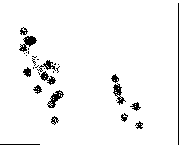
The second part is a region where there are various other trees.
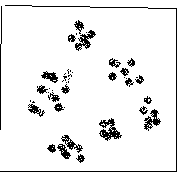
The following two units are random
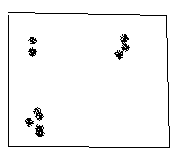
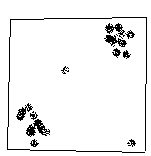
Looking at the first diagram, the organisms have clustered together along a river bank whilst in the second diagram. They have been distributed in groups with spaces between them. For the two random units, there are places with nothing and others with spaced out clusters. A fair diagram with all of them looks something like this.
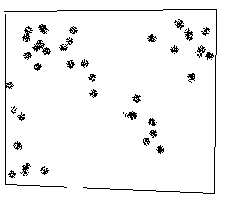
Compared to the diagrams in the book, this is almost similar to the clumped mode (Smith and Smith 2009).
Discussion
The first sample was taken from the distribution of the shrubs which were mostly along the riverbanks. They happen to grow together following the course of the river. The second diagram shows the small trees which were growing together with other trees. The small trees also were growing together in distinct areas. One could easily identify the difference between the small trees and the shrubs from the size. Shrubs are bushy and barely 4 meters tall whilst the trees formed a canopy and were about 6 meters.
The random areas were generated from areas close to the rivers at random. Some areas which fell near other trees or near river banks had the organisms distributed in clusters and it was so rare to get a solitary Euclea divinorum plant. This then tells that the organisms are distributed in clusters (Smith and Smith 2009).
The main reason for choosing this plot is first due to the interesting nature of the plant which makes it so famous due to its various uses. Secondly, it is due to the reason that in an area close to a river, it was possible to find the two types of the plant within range making it simple to carry out the experiment in this area. If the place was bigger than this, the almost linear pattern along the river would disappear but the other parts would remain the same. The plants were probably dispersed in this nature due to reproduction. It seems the fertility of the males and the females does not stay for long thus making them reproduce at close range. If the same experiment was repeated in a plot three times bigger than this, the diagram will almost be similar owing to the fact that the area is the same and once the plants start occupying a certain territory, the clusters do not change.
References
Smith, T. and Smith, R. (2009). Elements of Ecology. Boston: Benjamin Cummings